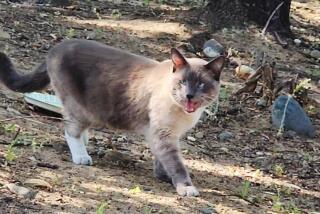Yes, this is really love
- Share via
What do you ask a man about his cat? Not much.
“So, you got any pets at home?
“Yeah, I have a cat.”
“Oh.”
And back to football.
This is possibly because many males believe that real men don’t have cats. Men are mainly dog people, the thinking goes, because dogs are companionably rough-and-tumble. They play catch, protect the homestead, go on hikes. They can be image enhancers, too, depending on the choice of grooming salons. Cats, on the other hand, groom themselves. To distraction. Just like some women. Cats are also (mistakenly) thought to be uncommunicative, unresponsive and ungrateful. Feed them every day, and the most they’ll do for you is show up for the next meal.
So it seemed an oddity when two books were recently written by dissimilar men on opposite coasts who both claim to have found true love with a cat. And who say their cats taught them how to be better humans.
The books are entertaining, if you don’t mind small furry creatures with limited repartee. But the quality of dialogue (cat-alogue?) is not at issue here. It’s the quality of the relationships between these men and their cats, the unusual candor each displays in confessing his unequivocal and unconditional mushy love for his creature.
“A Cat Named Darwin: How a Stray Cat Changed a Man Into a Human Being” (Houghton Mifflin), by William Jordan, and “The Cat Who’ll Live Forever: The Final Adventures of Norton, the Perfect Cat and His Imperfect Human”(Broadway Books), by Peter Gethers, are both homages to now-deceased pets -- and to the life lessons they taught their people.
Gethers, 49, is gregarious -- a bon vivant, raconteur, world traveler, successful publisher (he co-founded Villard press, an imprint of Random House). He is the author of novels, mysteries, and film and TV scripts, and a dropper of famous names on many continents, luminaries with whom he and his cat have consorted over the years.
Gethers is physically imposing -- tall, dark, broad, burly. He’d been a dog person all his life, he says. In fact, he once made a list for a girlfriend of 10 irrevocable things she should know about him. No. 10 was: “I hate cats.”
Gethers became a literary hotshot right out of college. As an editor at Bantam Books, he picked winning manuscripts that became bestsellers, writing novels and screenplays in his spare time. At 24, he parlayed all this into a dream job: six months a year at the publishing house, the other six months at liberty to write. He was hired by Random House, where he worked the same kind of deal, only better. By 1983, at 30, he had the looks, the moves, the money to get almost any Gotham girl he wanted -- and he wanted most of them. He became a “serial dater,” someone whose romances never went deep or lasted long. “I was your typical arrogant, insensitive, greedy New York lout,” he says.
Then his girlfriend of the moment surprised him with a kitten. He wouldn’t look at it. She forced the tiny fur ball into his capacious palm -- and one of the world’s great love stories began. The lady vanished; the cat stayed. His name was Norton.
At first, Gethers toted Norton around in his coat pocket, the cat’s tiny body inside, his head outside, swiveling to take in the sights. Norton enjoyed subways, cabs, cafes, meetings, even the dating rituals of his “dad.” When he liked a girl, he cuddled up to her. When he didn’t, Gethers learned, there was often good reason. Norton’s brilliance startled strangers. The cat answered when called, waited patiently for Gethers outside places where animals weren’t allowed. “A genius,” Gethers would frequently say.
As he began traveling more frequently for work, Norton went along in an open-top canvas shoulder bag. They hit Spain, Italy, Holland, France (often by Concorde). Flight attendants, hoteliers and five-star chefs adored Norton. In Parisian restaurants, he sat on a chair, dined on herring tidbits and foie gras, and acted dignified while Gethers socialized with folks such as Roman Polanski and Harrison Ford. Their favorite hotel room had French doors, through which Norton had access to the roofs of Paris.
A New York editor noticed Norton, learned of the pair’s adventures in Paris and said: “You have to write a book and call it ‘The Cat Who Went to Paris.’ ” Gethers did.
It was published in 1991, became a bestseller, is still in print. It made Norton the most famous real-life pet cat in history. Now he was recognized not just by friends, but also by total strangers in Sag Harbor, Sicily, Madrid. In Amsterdam, a woman walked up and asked Norton, “Are you the Cat Who Went to Paris?” People now talked to him, ignoring Gethers, as if they thought the cat could answer.
A second Norton book, “A Cat Abroad,” was published in 1993.
Norton soon took a shine to one of Gethers’ friends, Janis. Gethers liked her too -- and the cat-man duo soon became a trio, with Janis the love interest for both males. The two humans are still together -- although Norton left them on May 12, 1999. He is the only domestic feline ever to have rated a full-fledged obituary in the New York Times -- with a photo. It began: “Norton, a grayish cat with small folded ears, whose far-flung adventures were described in two books, died on Saturday. He was 16, said the person with whom he lived, the author Peter Gethers.”
The new book details Gethers’ life after Norton’s illness was diagnosed. It is filled with love and fun -- and the necessary sadness. He says he wrote this final opus because he realized that “until Norton, my relationships were not good. Then I fell so madly in love with this cat, and he taught me how to fall in love with people. One woman in particular. He made me a better partner, a better writer, taught me about getting older, being sick and being a caretaker, which I thought I could never be for anybody. I cared for him like you would an aged parent. And that changed me. What I learned from Norton is that I am absolutely capable of commitment.”
Gethers is now writing the film script of Norton’s tale for Jane Rosenthal and Robert De Niro’s Tribeca Entertainment.
William Jordan is a fastidious, fair-haired, compact “man of science.” By his own account, he has led a rigorous, almost monastic life. A student until 30, when he earned a doctorate in biology at Berkeley, he then rented a spartan space in Long Beach, where he wrote for scientific journals. He had no love of cats. “I used to kill cats as a kid on the farm. I’d just blow them away with a .22,” he says in a surprised tone, as if he can’t believe he ever did that.
Jordan is a speed talker, a man whose sentences trip over themselves racing to the next thought. For him, biology explains all human behavior. Speaking in the book-lined living room of his small Culver City house, he launches into his theories on the ability to kill, ending with: “There’s an on-off switch in the human brain that lets people do things they consider repugnant if they believe they have to do them. That compassion on-off mechanism is the major element in all human affairs.”
Yes, but back to the cat? Jordan was 44, single, living alone. “Oh, I’d had affairs, but they went nowhere. I was getting tired of just doing things for myself.” One day he took some papers out to the trash and saw an abandoned cat that had been hanging around for about a year. “Usually he ran when I came out. This time he didn’t. I was compelled to say something. I go meow. He goes meow. He walks toward me. I put my papers down and get on my hands and knees. He comes close, reaches up, touches my nose with his paw. I put my head down more, he touches his nose to my nose. So I start petting him. He turns around and bites my hand.”
Jordan says he didn’t realize it was a love bite. “I’ve seen what cats can do. A little cat could probably kill you if it wanted to. They have the canines, the carnassials, the molars. All designed for cutting and slicing. Basically, a cat’s mouth is like a Swiss army knife.”
He started feeding the cat. Then letting it in for short periods. He got it the shots, the flea bath, the collar. He named it Darwin. Pretty soon, man and cat were communing, to use Jordan’s word. “You do not communicate with a cat. You commune. Your inner lizard and his inner lizard connect. Not with words or thoughts, but with gestures, postures, sounds that are basically emotional.”
Jordan launches into how the human brain evolved from the animal brain and houses a “reptilian complex,” so named because it came from the lizard. The reptilian complex is “where appetites and feelings are generated in both species.”
Man, however, has the advantage of a well-developed cerebral cortex, which provides the ability to reason and calculate. “So if I see an attractive woman, my inner lizard tells me to grab her. My cerebral cortex tells me if I do it I’ll go to jail.” Or something.
Jordan and Darwin became exquisitely attuned. They “conversed” through stroking. At a certain point, the cat began staring intently at Jordan. “They don’t do that until they’ve bonded. When that happens, you are soul mates. You are one.”
The first time Jordan allowed Darwin into his bed, “I thought, My God. I’m in a relationship with a cat.” Then, their first real lovers’ quarrel: “We were conversing. Suddenly, Darwin dug into my wrist with his claws. It scared me. I decided to get rid of him.” But no one would take the cat. “So we had to go on. Just like in a human relationship. And we got past it. That’s the lesson I learned.”
He talks about Darwin as he would a spouse. Is that, uh, normal? “It’s the love thing,” he says. “Yes, it’s the same brain machinery. It’s all about evolution, and evolution is about kinship, and kinship is about love.”
After about two years, the cat was diagnosed with an ultimately fatal illness. It was the dawning of a new set of revelations for Jordan.
His theory: “When humans relate to others, nerves get recruited, molecules laid down, pathways are formed. The longer you are with that person or animal, the more extensive and complex is the brain pathway devoted to the relationship,” he reasons. “When the animal or person dies, the brain pathway isn’t needed anymore. I think that’s where the pain of grief comes from.”
Happily, it turned out that Darwin had quite a few months of normal activity ahead of him. Eventually the cat slowed down; he let Jordan know when the end was near and how to handle it. Like Gethers, Jordan says his cat comforted him, rather than the other way around. Their stories are not so different after all. After lengthy periods of grief and healing, both authors are once again in relationships. With cats.
More to Read
Sign up for our Book Club newsletter
Get the latest news, events and more from the Los Angeles Times Book Club, and help us get L.A. reading and talking.
You may occasionally receive promotional content from the Los Angeles Times.







